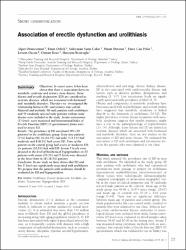| dc.contributor.author | Otunçtemur, Alper | |
| dc.contributor.author | Özbek, Emin | |
| dc.contributor.author | Çakır, Süleyman Sami | |
| dc.contributor.author | Dursun, Murat D. | |
| dc.contributor.author | Polat, Emre Can | |
| dc.contributor.author | Özcan, Levent | |
| dc.contributor.author | Köse, Osman | |
| dc.contributor.author | Beşiroğlu, Hüseyin | |
| dc.date.accessioned | 10.07.201910:49:13 | |
| dc.date.accessioned | 2019-07-10T19:35:50Z | |
| dc.date.available | 10.07.201910:49:14 | |
| dc.date.available | 2019-07-10T19:35:50Z | |
| dc.date.issued | 2014 | en_US |
| dc.identifier.citation | Otunçtemur, A., Özbek, E., Çakır, S. S., Dursun, M. D., Polat, E. C., Özcan, L. ... Beşiroğlu, H. (2014). Association of erectile dysfunction and urolithiasis. Archivio Italiano di Urologia e Andrologia, 86(3), 215-216. https://dx.doi.org/10.4081/aiua.2014.3.215 | en_US |
| dc.identifier.issn | 1124-3562 | |
| dc.identifier.uri | https://hdl.handle.net/20.500.12511/961 | |
| dc.identifier.uri | https://dx.doi.org/10.4081/aiua.2014.3.215 | |
| dc.description.abstract | Objectives: In recent years, it has been shown that there is association between metabolic syndrome and urinary stone disease. Stone disease and erectile dysfunction (ED) are considered as systemic diseases which are associated with hormonal and metabolic disorders. Therefore we investigated the relationship between ED and urinary tract calculi.Material and methods: 98 male patients with urolithiasis and 59 randomly selected male patients without stone disease were included in the study. Serum testosterone (T) levels were measured and International Index of Erectile Function (IIEF)-15 questionnaire forms were used to assess ED.Results: The prevalence of ED was found 29% (29 patients) in the urolithiasis group. Sixty-nine patients (71%) had no ED; 16 (16.3%) had mild, 5 (5.1%) had moderate and 8 (8.2%) had severe ED. None of the patients in the control group had severe or modarete ED, six patients (10.2%) had mild ED. Serum T levels were detected at the level of biochemical hypogonadism on 13 patients with stones (13.3%) and T levels were detected at the lower limit in 18 (18.3%) patients.Conclusion: In our study we have shown that ED and low T levels are significantly associated with urolithiasis. We propose that the patients with urolitiasis should be evaluated for ED and hypogonadism. | en_US |
| dc.language.iso | eng | en_US |
| dc.publisher | Edizioni Scripta Manent s.n.c. | en_US |
| dc.rights | info:eu-repo/semantics/openAccess | en_US |
| dc.subject | Erectile Dysfunction | en_US |
| dc.subject | Hypogonadism | en_US |
| dc.subject | IIEF | en_US |
| dc.subject | Metabolic Syndrome | en_US |
| dc.subject | Testosterone | en_US |
| dc.subject | Urolithiasis | en_US |
| dc.title | Association of erectile dysfunction and urolithiasis | en_US |
| dc.type | article | en_US |
| dc.relation.ispartof | Archivio Italiano di Urologia e Andrologia | en_US |
| dc.department | İstanbul Medipol Üniversitesi, Tıp Fakültesi, Cerrahi Tıp Bilimleri Bölümü, Üroloji Ana Bilim Dalı | en_US |
| dc.authorid | 0000-0001-5254-2563 | en_US |
| dc.identifier.volume | 86 | en_US |
| dc.identifier.issue | 3 | en_US |
| dc.identifier.startpage | 215 | en_US |
| dc.identifier.endpage | 216 | en_US |
| dc.relation.publicationcategory | Makale - Uluslararası Hakemli Dergi - Kurum Öğretim Elemanı | en_US |
| dc.identifier.doi | 10.4081/aiua.2014.3.215 | en_US |
| dc.identifier.scopusquality | Q3 | en_US |


















